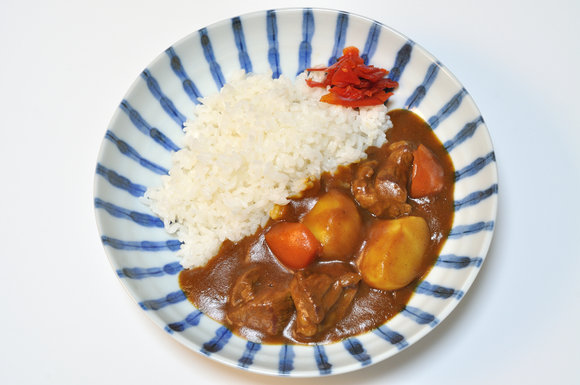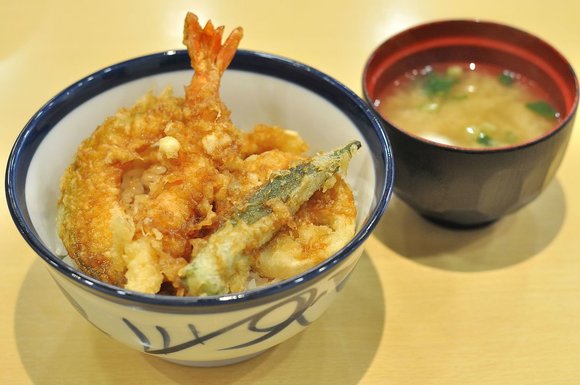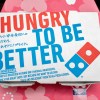
Despite its healthy holier-than-thou image, Japanese food has more than a few calorific goodies/evil temptations.
Coming from a land where deep-fried Mars bars and stonner kebabs are viable dinner choices, and hangovers are washed away with a fry-up from the local greasy spoon, I am more than reasonably well acquainted with high-calorie foods. It may surprise some people to learn that Japan has plenty of waistline exploding dining options (often in common-sense challenging o-mori extra large size) too, despite its carefully maintained image of being a land of simple, healthy fare.
Our Japanese-language sister site recently compiled a list of the top ten diet-undermining foods and here we will (in no particular order) introduce a selection that dieters may wish to avoid like the plague, and for non-dieters to indulge in life-enhancing/shortening gluttony with.
1. Curry rice
Not to be confused with Indian or Thai curry, this gravy-like gift from the British (you’re welcome) may contain spices (and therefore capsaicin, which can temporarily raise your fat-burning metabolism) but the roux it’s made from is horrifically high in fat. Add to that the starchy root vegetables and the mountainous piles of sugar-ridden white rice it’s usually ladled over and the result can derail one’s dietary plans at the first hurdle. If you find yourself unable to resist, you’re probably best going for a non-deep-fried seafood variety or a Hokkaido-style soup curry. Wack a half-cooked egg on top for protein and your diet may remain just about intact. And if you fancy trying your hand at making it yourself, here’s one we prepared earlier.
2. Tonkatsu
A pork steak covered in breadcrumbs and deep-fried. Despite being model-approved, served with a generous helping of high-calorie sauce and yet more white rice, Tonkatsu is best avoided if you’re counting calories. To make it slightly healthier, you can limit the calories by going for a leaner fillet cut (hirekatsu) over the usual loin steak (rosukatsu) and fill up on the shredded cabbage.
3. Tempura
Meat, seafood and vegetables deep-fried in tempura batter. While more expensive tempura restaurants will (or should) use higher quality and fresher oil, cheaper places are less picky and the calorie count rises accordingly. Go for a tempura on a bowl of rice (tendon) and you have fat and carbohydrates well and truly covered.
4. Ramen
This noodle-filled bowl of broth also manages to pack this double whammy of fat and sugars, especially if you favour the tonkotsu (pork broth) variety. Go for the oh-so-tempting second serving of noodles and you might as well start ordering elasticated waists for all your clothes. If you absolutely must eat ramen, stock up on vegetables and try not to slurp up all of the delicious life-giving stock. Remember that licking the bottom of the bowl is as frowned upon in Japan as it is elsewhere. And if ramen for your main course just isn’t enough ramen for one meal, you can try to track down a dessert version.
5. Kushikatsu
Not unlike tempura, but with breadcrumbs, and usually cheaper, kushi katsu are pieces of meat, seafood and vegetables covered in breadcrumbs, skewered and then deep-fried (a pattern may be beginning to emerge). Add to this that kushi katsu can often be found in all-you-can-eat style restaurants and it’s a delicious recipe for disaster.
6. Kashi pan
While bread may not be originally Japanese, kashi pan, sweetened breads and buns on the shelves of supermarkets and convenience stores across Japan, aren’t really found elsewhere. Take, for instance, an pan, bread with a sweet red bean filling (featured in the photo above) or melon bread. Even ostensibly savoury convenience store sandwiches will make use of this unnaturally soft and sugary bread so be warned.
7. Age-manju
While not on our sister site’s list, I couldn’t not include this delectable sweet treat. Similar to a filled doughnut, age-manju are steamed buns deep-fried and eaten hot with a variety of delicious fillings to choose from.
While of course most Japanese foods are fairly healthy, and Japan has very low obesity levels that reflect this, there is plenty of fat and sugar-laden junk food out there. Foods that the health-conscious are best to avoid or eat in moderation, but for those less worried about such concerns, there is also plenty to pig-out on. Feel free to suggest other guilty pleasures below (to steer clear of, obviously). Now, I am feeling a bit peckish…
Top image: Gahag
Insert images: Wikipedia/Ocdp, Wikipedia/ ayustety from Tokyo, Wikipedia/hirotomo, Wikipedia/Aiko99ann, Pakutaso, Wikipedia/tnojima
[ Read in Japanese ]








 Wear your love for Nissin Donbei noodle bowls on your bag with these cute mini charms
Wear your love for Nissin Donbei noodle bowls on your bag with these cute mini charms The top 10 most popular instant noodle brands at the start of 2021
The top 10 most popular instant noodle brands at the start of 2021 Japanese bakery’s new Vegan Curry Bread is awesome enough to please even carnivores【Taste test】
Japanese bakery’s new Vegan Curry Bread is awesome enough to please even carnivores【Taste test】 Eat like a big kid at this Kyoto cafe with their “Kids’ Special” just for grownups!
Eat like a big kid at this Kyoto cafe with their “Kids’ Special” just for grownups! Melon bread: everyone’s favorite Japanese snack is actually one of the worst things you can eat
Melon bread: everyone’s favorite Japanese snack is actually one of the worst things you can eat McDonald’s new Happy Meals offer up cute and practical Sanrio lifestyle goods
McDonald’s new Happy Meals offer up cute and practical Sanrio lifestyle goods All-you-can-drink Starbucks and amazing views part of Tokyo’s new 170 meter-high sky lounge
All-you-can-drink Starbucks and amazing views part of Tokyo’s new 170 meter-high sky lounge Studio Ghibli glasses cases let anime characters keep an eye on your spectacles
Studio Ghibli glasses cases let anime characters keep an eye on your spectacles Beautiful Sailor Moon manhole cover coasters being given out for free by Tokyo tourist center
Beautiful Sailor Moon manhole cover coasters being given out for free by Tokyo tourist center More foreign tourists than ever before in history visited Japan last month
More foreign tourists than ever before in history visited Japan last month Super Nintendo World expansion gets delayed for several months at Universal Studios Japan
Super Nintendo World expansion gets delayed for several months at Universal Studios Japan McDonald’s Japan releases a pancake pie for new retro kissaten coffeeshop series
McDonald’s Japan releases a pancake pie for new retro kissaten coffeeshop series The oldest tunnel in Japan is believed to be haunted, and strange things happen when we go there
The oldest tunnel in Japan is believed to be haunted, and strange things happen when we go there Gacha machine backpack is Japan’s hottest new fashion statement
Gacha machine backpack is Japan’s hottest new fashion statement All-you-can-eat yakiniku in Shinjuku for less than 10 bucks!
All-you-can-eat yakiniku in Shinjuku for less than 10 bucks! Disney princesses get official manga makeovers for Manga Princess Cafe opening in Tokyo
Disney princesses get official manga makeovers for Manga Princess Cafe opening in Tokyo Starbucks reopens at Shibuya Scramble Crossing with new look and design concept
Starbucks reopens at Shibuya Scramble Crossing with new look and design concept Beautiful new Final Fantasy T-shirt collection on the way from Uniqlo【Photos】
Beautiful new Final Fantasy T-shirt collection on the way from Uniqlo【Photos】 Is the new Shinkansen Train Desk ticket worth it?
Is the new Shinkansen Train Desk ticket worth it? Foreign English teachers in Japan pick their favorite Japanese-language phrases【Survey】
Foreign English teachers in Japan pick their favorite Japanese-language phrases【Survey】 Japanese convenience store packs a whole bento into an onigiri rice ball
Japanese convenience store packs a whole bento into an onigiri rice ball We try out “Chan Ramen”, an underground type of ramen popular in the ramen community
We try out “Chan Ramen”, an underground type of ramen popular in the ramen community Studio Ghibli releases Kiki’s Delivery Service chocolate cake pouches in Japan
Studio Ghibli releases Kiki’s Delivery Service chocolate cake pouches in Japan Japan’s bone-breaking and record-breaking roller coaster is permanently shutting down
Japan’s bone-breaking and record-breaking roller coaster is permanently shutting down New definition of “Japanese whiskey” goes into effect to prevent fakes from fooling overseas buyers
New definition of “Japanese whiskey” goes into effect to prevent fakes from fooling overseas buyers Our Japanese reporter visits Costco in the U.S., finds super American and very Japanese things
Our Japanese reporter visits Costco in the U.S., finds super American and very Japanese things Studio Ghibli unveils Mother’s Day gift set that captures the love in My Neighbour Totoro
Studio Ghibli unveils Mother’s Day gift set that captures the love in My Neighbour Totoro Foreign passenger shoves conductor on one of the last full runs for Japan’s Thunderbird train
Foreign passenger shoves conductor on one of the last full runs for Japan’s Thunderbird train Domino’s Japan now sells…pizza ears?
Domino’s Japan now sells…pizza ears? New Japanese KitKat flavour stars Sanrio characters, including Hello Kitty
New Japanese KitKat flavour stars Sanrio characters, including Hello Kitty Kyoto creates new for-tourist buses to address overtourism with higher prices, faster rides
Kyoto creates new for-tourist buses to address overtourism with higher prices, faster rides Sales of Japan’s most convenient train ticket/shopping payment cards suspended indefinitely
Sales of Japan’s most convenient train ticket/shopping payment cards suspended indefinitely Sold-out Studio Ghibli desktop humidifiers are back so Totoro can help you through the dry season
Sold-out Studio Ghibli desktop humidifiers are back so Totoro can help you through the dry season Japanese government to make first change to romanization spelling rules since the 1950s
Japanese government to make first change to romanization spelling rules since the 1950s Ghibli founders Toshio Suzuki and Hayao Miyazaki contribute to Japanese whisky Totoro label design
Ghibli founders Toshio Suzuki and Hayao Miyazaki contribute to Japanese whisky Totoro label design Doraemon found buried at sea as scene from 1993 anime becomes real life【Photos】
Doraemon found buried at sea as scene from 1993 anime becomes real life【Photos】 Tokyo’s most famous Starbucks is closed
Tokyo’s most famous Starbucks is closed One Piece characters’ nationalities revealed, but fans have mixed opinions
One Piece characters’ nationalities revealed, but fans have mixed opinions We asked a Uniqlo employee what four things we should buy and their suggestions didn’t disappoint
We asked a Uniqlo employee what four things we should buy and their suggestions didn’t disappoint Princesses, fruits, and blacksmiths: Study reveals the 30 most unusual family names in Japan
Princesses, fruits, and blacksmiths: Study reveals the 30 most unusual family names in Japan Japan super budget dining – What’s the best way to spend 1,000 yen at Family Mart?
Japan super budget dining – What’s the best way to spend 1,000 yen at Family Mart? The newest must-eat Japanese KitKats: Deep-fried KitKat katsu on sticks
The newest must-eat Japanese KitKats: Deep-fried KitKat katsu on sticks Japanese beef bowl chain Matsuya now lets you exchange your rice for a salad, for free
Japanese beef bowl chain Matsuya now lets you exchange your rice for a salad, for free What’s really for breakfast? 20 Japanese people give us a peek at their morning meal【Photos】
What’s really for breakfast? 20 Japanese people give us a peek at their morning meal【Photos】 No one asked but we did it anyways: MOS rice patty burgers X ochazuke【Taste test】
No one asked but we did it anyways: MOS rice patty burgers X ochazuke【Taste test】 It’s OK to eat ramen every day, says Japanese doctor…as long as it’s not one type
It’s OK to eat ramen every day, says Japanese doctor…as long as it’s not one type Fisherman’s izakaya serves up awesome fresh seafood in Tokyo
Fisherman’s izakaya serves up awesome fresh seafood in Tokyo Mr. Sato gorges on Michelin-quality dim sum for his birthday, eats like a king for cheap
Mr. Sato gorges on Michelin-quality dim sum for his birthday, eats like a king for cheap Fashion brand Diesel is now selling curry in Tokyo thanks to latest stylish cuisine crossover
Fashion brand Diesel is now selling curry in Tokyo thanks to latest stylish cuisine crossover Unlimited kushiage skewers, stewed oden, and booze at this Tokyo restaurant for under 20 bucks
Unlimited kushiage skewers, stewed oden, and booze at this Tokyo restaurant for under 20 bucks We try making a low-calorie katsu with tofu instead of pork【SoraKitchen】
We try making a low-calorie katsu with tofu instead of pork【SoraKitchen】 Get delicious bread at…a fresh seafood market in Tokyo’s Okachimachi neighborhood?
Get delicious bread at…a fresh seafood market in Tokyo’s Okachimachi neighborhood? Think you’ve had every type of tempura? Not until you’ve eaten deep-fried maple leaves
Think you’ve had every type of tempura? Not until you’ve eaten deep-fried maple leaves We make delicious, low(er)-calorie Japanese-style pizza with fried tofu and miso!【Sora Kitchen】
We make delicious, low(er)-calorie Japanese-style pizza with fried tofu and miso!【Sora Kitchen】 This Tempura Soba Burger has some famous credentials behind its creation
This Tempura Soba Burger has some famous credentials behind its creation
Leave a Reply